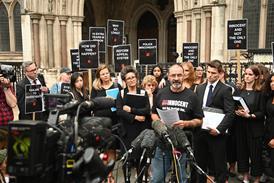Legal services orders came into effect from 1 April 2013. It is the first form of entirely new order since the introduction of pension sharing orders in December 2000. Despite this significant development, anecdotally, few legal services orders have been made.
Having given several lectures around the country over the last year on financial remedy updates, when the issue of legal services orders was covered, I asked the audience to indicate how many had secured legal services orders since their inception. In most cases, not one person in the audience had obtained such an order.
What is a legal services order?
Sections 22ZA and 22ZB have been inserted into the Matrimonial Causes Act 1973. By virtue of section 22ZA(1), the court may make an order, or orders, requiring one party of the marriage to pay to the other an amount ‘for the purpose of enabling the applicant to obtain legal services for the purposes of the proceedings’.
Orders may be made in divorce, nullity or judicial separation proceedings and there are mirror provisions in the Civil Partnership Act. An order may be a one-off payment, or can be made in instalments, for example on a monthly basis. An order may be varied if there is a material change in circumstances and an order may be made on more than one occasion within proceedings.
Factors for the court to consider in making an order are set out in section 22ZB and include such issues as the income, earning capacity and resources of the parties, their needs and obligations, the subject matter of the proceedings and the conduct of the applicant in relation to the proceedings.
It can be seen that a legal services order is a statutory form of order which is broadly similar to the form of order introduced in A v A (Maintenance Pending Suit: Provision for Legal Fees) [2001] 1 FLR 377.
In that case it had been established that the court’s power to make maintenance pending suit orders under section 22 of the Matrimonial Causes Act 1973 was wide enough to enable the court to make an award for payment of the wife’s ongoing legal fees in the matrimonial litigation. As will be seen below however, A v A orders were easier to obtain than legal services orders.
High hurdle
The provisions of section 22ZA set what was, on the face of it, an impossibly high hurdle to secure a legal services order. By virtue of section 22ZA(3), the court must not make a legal services order unless it is satisfied that, without the amount, ‘the applicant would not reasonably be able to obtain appropriate legal services’.
Further, under section 22ZA(4), the court must be satisfied that in particular: (a) the applicant is not reasonably able to secure a loan to pay for legal services; and (b) the applicant is unlikely to be able to obtain the legal services by granting a charge over any assets recovered in the proceedings.
In view of the number of specialist litigation lenders now on the market, it was anticipated that few applicants would be able to clear the first hurdle. The availability of litigation funding would mean that most applicants would surely be able to secure a loan to pay for legal services. That would therefore preclude them from securing a legal services order.
Rubin v Rubin
The decision of Mr Justice Mostyn (pictured) in Rubin v Rubin [2014] EWHC 611 (Fam) is a major development and should mean in practice a significant increase in the number of legal services orders being granted. In a comprehensive judgment, Mostyn J established 14 principles which apply to an application for a legal services order.
Of particular note are Mostyn J’s comments regarding the availability of litigation loans. On that issue he stated: ‘If a litigation loan is offered at a very high rate of interest it would be unlikely to be reasonable to expect the applicant to take it unless the respondent offered an undertaking to meet that interest, if the court later considered it just so to order’.
Also on the issue of the availability of loans, Mostyn J adopted the same approach he had taken in TL v ML [2005] EWHC 2860 (Fam), which was made in the context of an A v A order, as discussed above. He stated: ‘Evidence of refusals by two commercial lenders of repute will normally dispose of any issue under section 22ZA(4)(a) whether a litigation loan is or is not available.’
From the 14 points of principle, there are several of particular note. Mostyn J stated that in determining whether the applicant can reasonably obtain funding from another source, the court would be unlikely to expect them to sell or charge their home or to deplete a modest fund of savings.
He went on to say that this aspect was, however, highly fact-specific.
If the family home was of such a value that it appears likely that it will be sold at the conclusion of the proceedings, then it may well be reasonable to expect the applicant to charge their interest in it.
The second limb of the test under section 22ZA(4) considers whether the applicant is able to obtain legal services by granting a charge over any assets recovered in the proceedings. This can be dealt with by a clear statement of refusal by the applicant’s solicitors to accept such a charge. This approach again reflected the test previously established in TL v ML.
As the court cannot make an order unless it is satisfied that without the payment the applicant would not reasonably be able to obtain appropriate legal services, Mostyn J concluded that therefore the exercise essentially looks to the future.
Accordingly, a legal services order should only be awarded to cover historic unpaid costs where the court is satisfied that, without such a payment, the applicant will not reasonably be able to obtain in the future appropriate legal services for ongoing proceedings.
Mostyn J also noted that monthly instalments were preferable to a single lump sum payment as such an arrangement more accurately reflects what would happen if the applicant were paying her lawyers from her own resources. Furthermore, generally speaking, the court should not fund the applicant beyond the financial dispute resolution (FDR), but the court should grant a hearing date for further funding to be fixed shortly after the FDR, should the hearing be unsuccessful.
In summary, although applicants for legal services orders must be careful to satisfy the test contained in sections 22ZA and 22ZB, Mostyn J’s decision in Rubin should mean that significantly more legal services orders are granted in future.
Andrew Newbury is head of personal legal services at Pannone, part of Slater & Gordon
Click here to view more articles in our private client section





























No comments yet